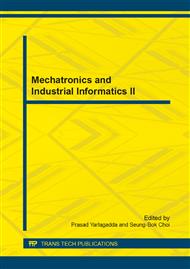[1]
Zhen Mei, Shuiming Chen, Qinwei Gu, et al. Statistic of lightning accidents during 1998~2004 in China. High Voltage Engineering. Vol. 33 (2007), pp.173-176.
Google Scholar
[2]
Xingli Dong, Yaozhong Ge, Xinzhou Dong. Effect of lighting on protection based on traveling waves. Proceedings of the CSEE, Vol. 22 (2002), pp.74-78.
Google Scholar
[3]
Hui Yi, Jiangliu Cui. The present state and lighting protection of transmission line in china. High Voltage Engineering, Vol. 27(2001), pp.44-50.
Google Scholar
[4]
Jiahong Chen, Qin Zhang, Wanxing Feng, et al. Lightning location system and lightning detection network of China power grid. High Voltage Engineering, Vol. 34 (2008), pp.425-431.
Google Scholar
[5]
Hao Wu, Xianyong Xiao. Lighting strike location of transmission line based on wavelet transform and traveling wave theory. High Voltage Engineering, Vol. 33 (2007), pp.86-90.
Google Scholar
[6]
Dipankar C, Kis hore N K, Avinash K S, et al. A wavelet multiresolution based analysis for location of the point of strike of a lightning over voltage on a transmission line. IEEE Trans on Power Delivery, Vol. 19 (2004), pp.1727-1733.
DOI: 10.1109/tpwrd.2004.835382
Google Scholar
[7]
Jiandong Duan, Baohui Zhang, Zhiguo Hao, et al. Identification of lighting strike and fault in the EHV transmission line transient-based protection. Automation of Electric Power Systems, Vol. 28(2004), pp.30-35.
Google Scholar
[8]
Guibin Zou, Houlei Gao, Feng Zhu, et al. Integral identification method of lighting stroke and fault for transmission line. Power System Protection and Control, Vol. 40(2012), pp.43-48.
Google Scholar
[9]
Gang Wang, Haifeng Li, Jiancang Zhao, et al. Identification of transients on transmission lines caused by direct lightning strike based on multiresolution signal decomposition. Proceedings of the CSEE, Vol. 24 (2004), pp.139-144.
Google Scholar
[10]
Hao Wu, Xianyong Xiao, Wujun Deng. Identification of lighting strike and fault in the traveling wave location of transmission line. High Voltage Engineering, Vol. 33 (2007), pp.63-67.
Google Scholar
[11]
Hao Wu, Xianyong Xiao, Ruijiao Shen. Lightning strike and fault identification by the wavelet energy spectrum and neural network method. High Voltage Engineering, Vol. 33 (2007), pp.64-68.
Google Scholar
[12]
Zhengyou He, Xiaoqin Chen. A study of electric power system transient signals identification method based on multi-scales energy statistic and wavelet energy entropy. Proceedings of the CSEE, Vol. 26 (2006), pp.33-38.
Google Scholar
[13]
Songlin Xu, Shaoxian Huang. Fault diagnosis of commutation failures in the HVDC system based on the wavelet energy spectrum and grey comprehensive relationship degree. Power System Protection and Control, Vol. 40 (2012), pp.85-89.
Google Scholar


